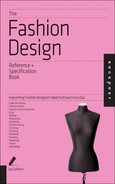
Job:02-30034 Title:RP-Fashion Design Ref and Spec Book
#175 Dtp:225 Page:95
Book
ge:94
090-095_30034.indd 95 2/27/13 4:18 PM
Pro les 9 5
(Text)
y
s,
st
e
BRACKETING
Once designers have pinpointed their customer, they receive the added bene t of automatic
bracketing. The segment of the population who constitute the next generation or those who
have aspirations to the lifestyle associated with it form one side of the bracket. Teens have
historically been very receptive to clothing that might afford them the illusion of the privileges
of adulthood. The other side of the bracket is made up of that part of the population inter-
ested in recapturing an aspect of the target’s lifestyle that they have already experienced, or
perhaps missed. Boomers who dedicated their youth to raising families might have developed
an appetite for fashion that is infused with the vitality and vibrancy normally associated with
a younger customer. If designers remain constant to their ideal client, their work will project
authenticity, something that will be attractive across a wide spectrum.
ANALYSIS
After all the data mining has taken place, designers have two primary methods of assessment.
They can learn to predict how their target audience will respond to their work based on cus-
tomer histories gathered over time, or they can segment their audience based on the combined
pro le data. Well-executed research will provide a wealth of information, allowing designers
to create an in-depth, well-rounded customer model. Designers will then want to learn how to
manage the relationships they have with their customers, guring out how and when to engage
them and with what product or service.
In the midst of all this intelligence gathering, it is easy to forget that the dynamic between the
designer and the client is not a straight line. Collecting feedback to make course corrections
and manage expectations is an ongoing process. The eagerness of the aspirational customer
should not be underestimated and should be a component of the evaluation. These customers
may not be the designer’s primary objective, but they will often go far out of their way to buy
into a particular aesthetic if the designer provides them with a point of entry.
In the end, when making decisions based on research about human beings, designers need
to remember that, no matter how sophisticated the model, they are only making educated
guesses. The moment a nal conclusion is drawn about any person or any group is exactly the
same moment the lock on it begins to lose its grip. A designer must never assume de nitively
to know what’s best. Designers that evolve with their client base succeed. Designers that
anticipate the transformational curve excel.
08
Job:02-30034 Title:RP-Fashion Design Ref and Spec Book
#175 Dtp:225 Page:95
Book
ge:94
090-095_30034.indd 95 2/27/13 4:18 PM
..................Content has been hidden....................
You can't read the all page of ebook, please click here login for view all page.
